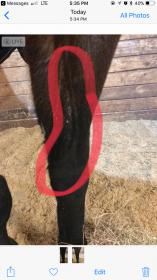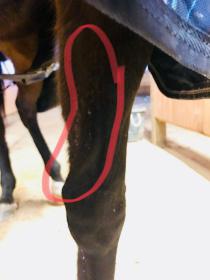Some background: Horse is a 4 year old Thoroughbred gelding, came off the track September 2017, I purchased in October 2017. No PPE (don’t believe it’s relevant in this case but someone always wants to know :)) - history was very straightforward (one owner/trainer, retired due to being unable to break maiden in 10 starts, ran consistently over the span of a year), legs were clean and tight, and there was nothing in his way of going or demeanor that suggested there was anything to worry about. Has been sound since coming home except for some minor footsoreness after pulling shoes (at farriers recommendation) in the beginning of December.
Two weeks ago barn manager called to let me know that my farrier had been out to trim Q’s feet and they had discovered his left front leg to be stocked up and swollen, particularly around the top of his knee and above. There was some heat around and above the knee but he was moving soundly on it and stood with no issue for the farrier. We iced it, magna-waved it, and then poulticed it and gave a gram of bute. Due to the fact he was moving soundly and not in distress and the swelling responded to the ice and magna-wave we elected to wait overnight and reassess the following day before calling the vet. He had been in his stall for nearly 24 hrs prior to this due to bad weather so our belief was that he probably knocked it somehow or got up awkwardly from laying down and just aggravated it - it was clearly non-emergent.
The following day the swelling had abated everywhere except for just around the top of the knee so we followed the same course of action with some supervised turnout to see if movement would help it go down the rest of the way. The morning of the third day saw no change so we called the vet.
Vet examined and determined the tendon sheath was inflamed, prescribed 10cc of Banamine paste for 3 days and 3D cream (DMSO, dex, and something else that starts with D that I can’t remember the name of) to be applied to the area and then poulticed over top of. He said the swelling should dissipate within the next four days and that he could then go back to work. Swelling/heat was gone completely by day 3 but we continued with rest and restricted turnout (turnout in one of the indoor/outdoor arenas with a chill buddy instead of his regular pasture where the footings frozen/uneven and his mates are rowdy) for about 4 days after.
This past Sunday I tacked him up and lunged before I got on (less than 5 minutes, just enough to see how he was moving and where his brain was since he had been off for so long) and observed he was sound at the walk but still off (slight limp and a head bob) at the trot. At trainers recommendation I tack walked him around the arena for 15-20 minutes to get him some exercise/stimulation. Afterwards I checked his knee/leg for heat/swelling and there was none (I continued to check every so often for about 3 hours afterwards and there continued to be none). Trainer recommended checking it again the following day (yesterday) before calling the vet back as she felt he might just be stiff from having been off and it being so cold or he might have been having some footsoreness as I had slacked with the Durasole since he hadn’t been on hard footing.
Yesterday evening I checked the area and found (what I believe to be) his extensor tendon to be inflamed with some heat. Still moving sound at the walk (did not attempt to jog him), full weight bearing, and unbothered by me palpating the area or lifting/flexing/extending the leg (inflamed area feels squishy to the touch). Sent images (below - they’re not great as its not really an easy thing to capture on a dark horse will a cell camera) to trainer who sent them to the vet (haven’t heard back). Went back to original treatment plan and DMSOed/poulticed in the interim. Will be calling vet out today though we’re in the middle of a winter storm so unsure if he’ll be able to make it out today.
[ATTACH=JSON]{“data-align”:“none”,“data-size”:“full”,“title”:“IMG_4801.JPG”,“data-attachmentid”:9991323}[/ATTACH][ATTACH=JSON]{“data-align”:“none”,“data-size”:“full”,“title”:“IMG_4797.JPG”,“data-attachmentid”:9991324}[/ATTACH]
Wow, that got really long haha. I guess I was just curious if anyone’s dealt with anything similar or had any words of encouragement/suggestion. I did a lot of reading last night on here and elsewhere about severed tendons and other gnarly things and promptly freaked myself way out even though this seems relatively minor in comparison.



 .
.